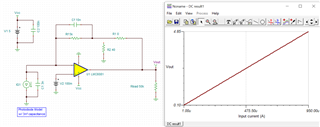Hi,
Attached circuit diagram of LMC6082 Amplifier used in my design below. Please explain how it works and operation for the better understanding. Is this configured as Photoconductive mode (Converts Photocurrent to output voltage) like Trans Impedance amplifier? How much Gain will be set using this circuit, Is it possible to explain with min and max values of Input Current/ Voltage and Output Current/ Voltage? I am not expertise in this topic so expecting the detailed explanation. Thanks in advance.

Regards,
Karthick V



